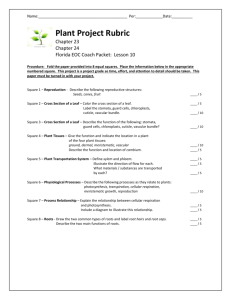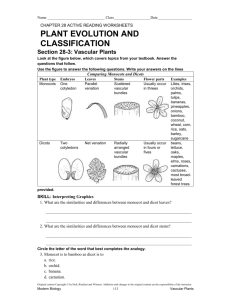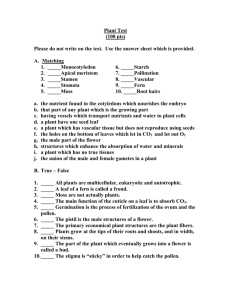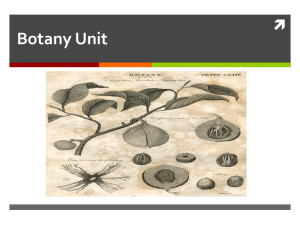plants - TPS11biology
advertisement
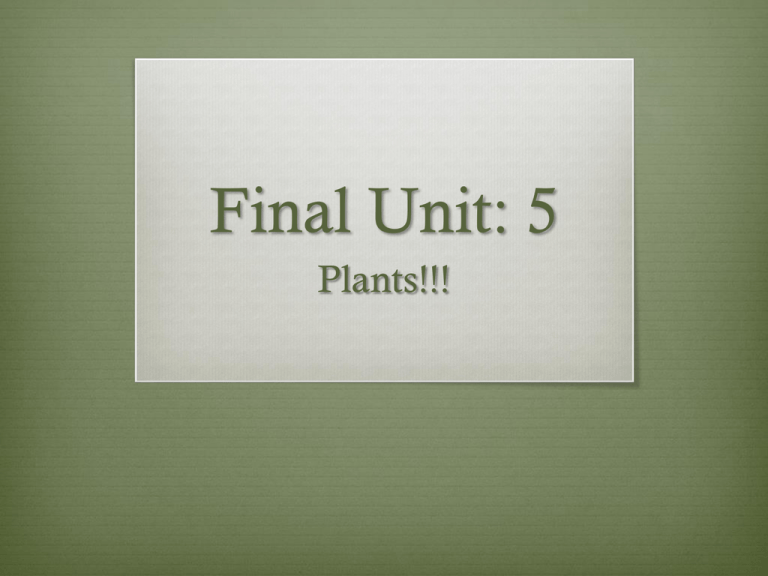
Final Unit: 5 Plants!!! Vascular plants 2 organ system Underground root system Anchors the plant by penetrating into the soil Root system absorbs water and nutrients Above-ground shoot system Made up of stems and leaves Leaves perform photosynthesis Stems bear the reproductive structures Shoot system Root system Dermal Tissue Outer covering of a plant Epidermis: single layer of dermal tissue forms a protective covering Guard cells: a specialized epidermal cells that surrounds the stoma Stoma: small opening usually in the leaf, that allows gas exchange to occur Vascular Tissue Internal system of tubes that run lengthwise throughout the stem, connecting roots and leaves Function: to transport water and dissolved substances 2 types: Xylem: transports water and minerals from roots to leaves Phloem: transports organic nutrients to areas needed for growth and metabolism Types of root systems 2 types of root systems Taproot Thick root with smaller lateral branching roots Tap into sources of water far below ground level Ex: Carrots Fibrous roots Made up of many smaller branching roots Grow from a central point Do not grow as deeply Ex: scallions Stems Main function: to provide support for the plant’s leaves and reproductive structures Tuber: enlarged part of an underground stem. Has buds extending from it that will grow into new potato plants. Bulbs: shortened, compressed stems surrounded by fleshy leaves (ie onions and tulips). Corms: composed almost entirely of stem tissue with some scaly leaves on top. Stolons: horizontal stems that grow above ground along the surface of the soil like strawberry plants. Rhizome: horizontal stems that grow underground. Leaves Cuticle: a waxy layer on the epidermis that is secreted by epidermal cells Mesophyll: the layer between the upper and lower epidermis of a leaf that contains chloroplast Palisade mesophyll: the layer of cells where most photosynthesis takes place, immediately below the epidermis Spongy mesophyll: the layer of irregularly shaped, loosely packed cells below the palisade mesophyll. Allows oxygen, CO2 and H2O to move around easily Identifying Leaves Venation: pattern of veins in a leaf Leaf type Leaf Venation Leaf Arrangement Monocot vs Dicot Organization of vascular tissue in roots and stems Monocot: Arranged in a ring Dicot: Roots arranged in star shape Venation Monocot: Veins parallel Dicot: Palmate or pinnate # of flowering plants Monocot: Multiples of threes Dicot: Multiples of four or five Root Monocot: Fibrous Dicot: Taproot Examples Monocot: Banana, onion, palm tree Dicot: Strawberry, cactus, rose tree Homework P.559 #3, 4, 11, 12, 15, 16 Transport in Plants Movement of water and nutrients Diffusion: net movement of particles from an area of high concentration to a low concentration Osmosis: diffusion with water These two occur naturally Active transport: to move sugar and nutrients cross cell membranes, need energy Transport in Xylem How can water move upward through trees and other plants when common sense tells us gravity should "pull" the water down The answer is in the xylem of the plants Water enters roots, rises through xylem, and exits through stomata and leaves. What helps water move through xylem? • Water moves through the xylem these factors: o a small "pushing" pressure from water entering roots o a larger "pulling" pressure cause by water evaporating called transpiration (process in which water evaporates from the inside of a leaf to the outside through the stomata) What about in tall trees? Negative pressure (pulling) from above is the strongest force for long-distance transport in plants This is called the Cohesion-tension model 3 main factors: 1. transpiration: evaporation of water is responsible for the movement of water and dissolved minerals upward in a plant. As water evaporates, more comes up the plant. 2. cohesion: water molecules sticking together 3. adhesion: water molecules stick to the xylem walls Nutrient transport in Phloem Translocation: transport of sucrose and other organic molecules Sink: any region in the plant where sugars are used or stored Pressure-flow model: explains how organic molecules from from source to sink Pressure-flow model Bulbs are covered by selectively permeable membrane – water can pass, not sucrose First bulb has high concentration Water flows into first bulb, and this creates a pressure difference between the two bulbs Some contents of first bulb are forced up into tube connecting both bulbs As pressure builds up in second bulb, water diffuses out When concentrations of sucrose are equal, flow stops Homework P.566 #1, 2, 3, 7 Sexual Reproduction in Angiosperms Angiosperm: A flowering plant Plants have 4 organs 1. Sepals: protects the flower bud, can look like small leaves or flower’s petals 2. Petals: attract pollinating insects and provide a platform to land 3. Stamens: male reproductive organs. Composed of a filament and anther. Filament supports anther, which contains cells that undergo meiosis and mitosis 4. Pistil: female reproductive organs. Composed of a stigma, style, ovary. Stigma and pistil is where pollination takes place. Pollination Transfer of mature pollen grains from the anther to the stigma -wind -insects -birds & other animals When a pollen grain lands on the stigma, it germinates and a pollen tube grows down through the style to an ovule (egg) Fertilization The sperm travels through the pollen tube to the ovule. The sperm & egg fuse forming the zygote (fertilized egg) –this grows into the plant embryo (cells grow by mitosis) *Self pollination –pollen from same flower *Cross pollination – pollen from a different flower - more variation The ovary and zygote (fertilized ovule) develop and ripen. *The ovule forms the seed and the ovary forms the fruit. A fruit is a ripened ovary The plant embryo uses food stored in the cotyledon of the seed until it develops leaves for photosynthesis Seed Germination When seeds disperse, they may begin to grow. As the seed matures, it loses water and enters dormancy (metabolic processes slow down) Germination: process of resuming growth after being dormant Radicle: structure created by the division and lengthening of embryonic root cells inside a germinating seed; it develops into the primary root of the plant Hypocotyl: a hook shaped structure in dicots that eventually emerges above the ground Techniques of Artificial Propagation The cloning of a plant from a portion of its stems, roots or leaves Cutting Cuttings are small pieces of stem with some leaves attached, the new plant grows from this. They can be placed in moist soil or water (and sometimes dipped in rooting powder). Grafting A cut stem of one plant (with good flower or fruit growth) (the graft) is taken and firmly attached to the rootstock of another plant (which has a strong, established root system) (the stock). Examples- roses, fruit trees Division A plant is split into 2, containing intact shoots and roots. Planted in a new location Homework: p.592 #3, 10, 13, 14a

